|

|

|

|

|

|
|
Tuesday,
April 10, 2007
 Saving
Places
- A
bout with the flu, a week backpacking in the Grand Canyon, and a boat
load of grading have kept me relatively idle on the blog front.
Time to jump back in . . . Saving
Places
- A
bout with the flu, a week backpacking in the Grand Canyon, and a boat
load of grading have kept me relatively idle on the blog front.
Time to jump back in . . .
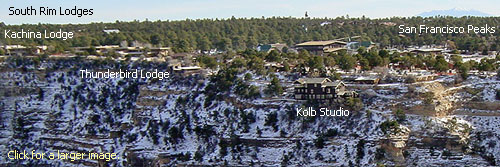 In the 1995
General Management Plan, adopted for Grand Canyon, the Park
Service planned to demolish
the Thunderbird and Kachina Lodges, which are located on the rim of
the canyon, between the El Tovar Hotel and the Bright Angel
Lodge. Why? I suppose the short answer is, "Because
they can." I think, though, that this proposal speaks to a
deeper character flaw in the people that run the NPS in general, and
the Grand Canyon in particular. They hate tourists. They
don't want people to go to the Grand Canyon, and, if they must come,
they don't want to stay near the rim. I guess that having people
really close to these magnificent views would somehow harm the canyon.
In the 1995
General Management Plan, adopted for Grand Canyon, the Park
Service planned to demolish
the Thunderbird and Kachina Lodges, which are located on the rim of
the canyon, between the El Tovar Hotel and the Bright Angel
Lodge. Why? I suppose the short answer is, "Because
they can." I think, though, that this proposal speaks to a
deeper character flaw in the people that run the NPS in general, and
the Grand Canyon in particular. They hate tourists. They
don't want people to go to the Grand Canyon, and, if they must come,
they don't want to stay near the rim. I guess that having people
really close to these magnificent views would somehow harm the canyon.
In the late 1990's, I circulated a flyer around during the Earth Day
celebration on the campus of Northern Arizona University, which asked
people to write to the superintendent to "Save the Kachina"
and to "Save the Thunderbird." OK, so it was a bit
tongue-in-cheek, since the nutjobs that attend these
"rallies" are not really interested in development that
promotes tourism.
Thankfully, the park service has been unable to carry through with
this part of its plan. So, the lodges remain. A few years
ago, while the Canyon Forest
Village proposal was getting the approval of our county Board of
Supervisors, the demise of these lodges was the focus of some
attention. The board decided that 900 rooms, at CFV, was enough,
but allowed for the possibility of future expansion, contingent upon
the removal of the Kachina and Thunderbird. Somehow, the notion
that tourists should stay overnight 7 miles from the rim, rather than
right on the rim, was thought to improve the quality of their
visits. Or, not.
Last week, there was a "listening session" held at the
Museum of Northern Arizona, where local park officials, including the
Superintendent from Grand Canyon, would hear what people had to say
about the parks. I wanted to attend, and actually planned on
it. But, the information on the timing of this session was
incorrect in the local paper, so, alas, I was unable to go and have my
voice heard. But, I am sure that all the usual suspects (i.e.,
local activists) did attend. In a follow-up article on this
event, in the local paper, former Grand Canyon resident, Bruce Aiken,
made some disparaging remarks about the Kachina and Thunderbird
lodges. So, I thought to pen a quick response, which ran in the
paper this past Easter Sunday:
|
To the
editor:
In a recent article about conditions at the Grand Canyon, a
former inner canyon resident is quoted as saying that the
Kachina and Thunderbird lodges are “disgusting” and that
“nobody likes” them. I would beg to differ.
These two lodges are hardly eyesores. They are nestled
between the El Tovar Hotel and the Bright Angel Lodge.
While they do not suffer from an overabundance of
architecturally-stimulating features, I would challenge
visitors to carefully consider these two structures from a
nearby vantage point along the West Rim Drive. Looking
back at the South Rim, with the San Francisco Peaks in the
background, you’ll hardly notice these lodges. Their
façade of buff colored stone-like panels make them blend in
well with the Kaibab Limestone, the uppermost rock layer of
the Grand Canyon. They do not crowd the rim, unlike the
Bright Angel, nor do they dominate a point, like the El Tovar.
Indeed, one would be hard pressed to find a better example of
“environmental sustainability” in the park.
I would bet that any visitor, staying at the Yavapai, or the
Maswik, or anywhere in Tusayan, would love to trade up to a
canyon-side room in either of these two lodges. With
occupancy rates in excess of 90%, it seems that plenty of
people like these rooms.
For
years, officials at the park have pursued a policy to demolish
these two lodges, to be replaced, not by another El Tovar,
but, instead, to be replaced by nothing. That would be a
crime. A crime not unlike ones committed by the Park
Service in the past, like when they destroyed the Grandview
and Summit, whose historical relevance was lost on officials
that seem driven to deter visitation rather than embrace it. |
In 2018 and
2021, these two lodges will be 50 years old, and may become eligible
to become historic
sites. It is not a slam dunk, and it is possible to get on
the list earlier, but I will bet that the park service will continue
to try to tear down these buildings before they can be officially
recognized as part of our history.
|
|

|
|
Wednesday,
April 11, 2007
 Nyet
on Newt
- C-Span
aired
a debate between Newt Gingrich and John Kerry, last night, on the
topic of global warming. I happened to be clicking through
channels, when I saw it, and stayed tuned for a while, thinking it
would Nyet
on Newt
- C-Span
aired
a debate between Newt Gingrich and John Kerry, last night, on the
topic of global warming. I happened to be clicking through
channels, when I saw it, and stayed tuned for a while, thinking it
would   be
a good debate. Not so. While I gave it a while, Newt was
buying into the idea that we must "do something" about
climate change, and argued that the debate should be about whether to
use mandated changes, to reduce carbon output, or use market-based
incentives. Yikes!! So much for him being a suitable
opponent in this debate. I am not ready to concede the point
that we must focus our attention on greenhouse gas output. It
seems much more prudent to deal with coping with this climate change,
rather than spend be
a good debate. Not so. While I gave it a while, Newt was
buying into the idea that we must "do something" about
climate change, and argued that the debate should be about whether to
use mandated changes, to reduce carbon output, or use market-based
incentives. Yikes!! So much for him being a suitable
opponent in this debate. I am not ready to concede the point
that we must focus our attention on greenhouse gas output. It
seems much more prudent to deal with coping with this climate change,
rather than spend billions
tens of
billions
hundreds of billions of dollars trying to "undo" these
effects, when the science is mushy, at best. At worst, the
science is being misrepresented to achieve political ends. An
excellent documentary on the topic is
The
Great Global Warming Swindle, which is currently posted up on
Google. I have seen it a couple of times already, and it does a
good job of laying out what the issues are in this debate. Alas,
we can only imagine how this debate would have been more compelling,
if Newt had championed reason instead of arguing about what policies
make more sense.
But, something to look forward to - the Pacific Research Institute is
releasing a film, this month, titled, "An
Inconvenient Truth ... Or Convenient Fiction?"
It sounds interesting and will be
on my viewing list.
|
|

|
|
Thursday,
April 19, 2007
 Clear
Creek
- An
acquaintance of mine from the Coconino Astronomical Society, Bill
Ferris, was recently smitten by the Grand Canyon bug.
Knowing that I have a lot of experience hiking the canyon, he started
asking me Clear
Creek
- An
acquaintance of mine from the Coconino Astronomical Society, Bill
Ferris, was recently smitten by the Grand Canyon bug.
Knowing that I have a lot of experience hiking the canyon, he started
asking me about hikes to take. Last fall, we did a couple of day hikes -
down to Plateau Point (on the Bright Angel Trail) and a
circumnavigation of Cardenas Butte (on the Tanner Trail). This
spring, Bill
got a permit for Clear Creek and graciously invited me along.
The trip was planned for six days and five nights - the first, and
last, at the Bright Angel Campground, and the middle three in Clear
Creek. Of course, I jumped at the chance to spend this nice,
big, chunk of time in the canyon...
about hikes to take. Last fall, we did a couple of day hikes -
down to Plateau Point (on the Bright Angel Trail) and a
circumnavigation of Cardenas Butte (on the Tanner Trail). This
spring, Bill
got a permit for Clear Creek and graciously invited me along.
The trip was planned for six days and five nights - the first, and
last, at the Bright Angel Campground, and the middle three in Clear
Creek. Of course, I jumped at the chance to spend this nice,
big, chunk of time in the canyon...
Follow this link and
read the full story, and see photos for the Clear
Creek hike.
|
|

|
|
Tuesday,
April 24, 2007
 Feckless
Republicans
- As
the party of Reagan, the party of "limited government" and
the party of free trade, there are plenty of Republicans that
disappoint . . . Feckless
Republicans
- As
the party of Reagan, the party of "limited government" and
the party of free trade, there are plenty of Republicans that
disappoint . . .
 Last year, our own Senator Jon Kyl
helped to ban internet
gaming, making him an enabler of the nanny state and an opponent
of freedom and liberty.
Last year, our own Senator Jon Kyl
helped to ban internet
gaming, making him an enabler of the nanny state and an opponent
of freedom and liberty.
 Our other Senator, John McCain
was the primary support of recent campaign financing "reforms"
that help erode our first amendment rights. If we believe that
money corrupts the political process, and who doesn't, then we need to
find ways to reduce the power that politicians have to rule, and ruin,
our lives.
Our other Senator, John McCain
was the primary support of recent campaign financing "reforms"
that help erode our first amendment rights. If we believe that
money corrupts the political process, and who doesn't, then we need to
find ways to reduce the power that politicians have to rule, and ruin,
our lives.
 A leading candidate for the Republican nomination for the presidency,
Mitt Romney, has called for energy
independence, which is as certain a way to bankrupt our economy
and lower our standards of living as is any phony global warming
legislation.
A leading candidate for the Republican nomination for the presidency,
Mitt Romney, has called for energy
independence, which is as certain a way to bankrupt our economy
and lower our standards of living as is any phony global warming
legislation.
 And, in this morning's paper, is a story about how
"Republican" state legislator, Marian
McClure, wants to ban all "high-interest lenders" in the
state. Curtailing choices for people with bad credit means that
they'll get no credit. That will, inevitably, lead to political
pressure to force sound financial institutions to allocate part of
their portfolio to "affordable lending," not unlike how we
blackmail home builders.
And, in this morning's paper, is a story about how
"Republican" state legislator, Marian
McClure, wants to ban all "high-interest lenders" in the
state. Curtailing choices for people with bad credit means that
they'll get no credit. That will, inevitably, lead to political
pressure to force sound financial institutions to allocate part of
their portfolio to "affordable lending," not unlike how we
blackmail home builders.
Feckless Republicans, one and all, and I haven't even mentioned Rudy,
nor the governator, nor Dub-ya. Wherever will we find some
conservative politicians that have any philosophical backbone?
|
|

|
|
Saturday,
April 28, 2007
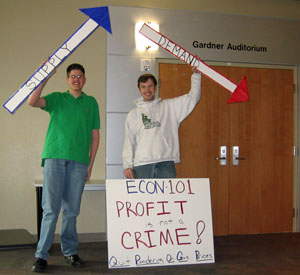  Two
Cheers for Capitalism
- You hardly ever see protests in favor of capitalism . . . but,
here's one! At Northern Arizona University's College of Business
Administration, two students showed up to protest a speech to be given
by Arizona
Attorney General Terry
Goddard. [Hmm, they do look vaguely familiar . . . sort of
like a couple of my past, or present, students.] Goddard has
been shilling the public a story that he can magically circumvent the
laws of supply and demand, by keeping gasoline prices from rising
during a supply disruption. He is, of course, just another
horse's . . . well, you can see his avatar below (I couldn't find a
better photo that did justice to his particular brand of lunacy). Two
Cheers for Capitalism
- You hardly ever see protests in favor of capitalism . . . but,
here's one! At Northern Arizona University's College of Business
Administration, two students showed up to protest a speech to be given
by Arizona
Attorney General Terry
Goddard. [Hmm, they do look vaguely familiar . . . sort of
like a couple of my past, or present, students.] Goddard has
been shilling the public a story that he can magically circumvent the
laws of supply and demand, by keeping gasoline prices from rising
during a supply disruption. He is, of course, just another
horse's . . . well, you can see his avatar below (I couldn't find a
better photo that did justice to his particular brand of lunacy).
 The students - Tim and Jason - protested by representing supply and
demand. Their sign reads, "Econ
101 - Profit is not a Crime." And, at the bottom of
the sign, is
written, "Quit Pandering
On Gas Prices." Who knows, maybe I'll try to recruit
them for a trip to the next WTO meeting, where we can help stage a
street march in favor of markets, capitalism, development, rising
standards of living, sanity and reason.
The students - Tim and Jason - protested by representing supply and
demand. Their sign reads, "Econ
101 - Profit is not a Crime." And, at the bottom of
the sign, is
written, "Quit Pandering
On Gas Prices." Who knows, maybe I'll try to recruit
them for a trip to the next WTO meeting, where we can help stage a
street march in favor of markets, capitalism, development, rising
standards of living, sanity and reason.
Most of what Goddard does as attorney general is pretty much
run-of-the-mill stuff that most people would say is fine. But,
there are some issues . . .
 Gas
price gouging.
He has "supported
two efforts in the Arizona Legislature to pass anti-price gouging
legislation." Lucky for us, they both went down
to defeat. But, if he becomes governor someday (like, the next
election), this issue will likely be further demagogued by him.
While he maintains that "[m]arket
forces are not working," he totally misses the point about
the role price serves to allocate scarce goods. So, for that, we
bestow upon him a blue ribbon, but he's still a horse's . . .
Gas
price gouging.
He has "supported
two efforts in the Arizona Legislature to pass anti-price gouging
legislation." Lucky for us, they both went down
to defeat. But, if he becomes governor someday (like, the next
election), this issue will likely be further demagogued by him.
While he maintains that "[m]arket
forces are not working," he totally misses the point about
the role price serves to allocate scarce goods. So, for that, we
bestow upon him a blue ribbon, but he's still a horse's . . .
 Payday
loans.
The issue of high interest rates for these types of loans has been
circulating around our state legislature for a while and it seems that
no good will come of this. Placing price ceiling on these
businesses will mean that they will impose higher standards on
customers, so that those with absolutely awful credit will just be out
of luck. Goddard says that he is
"concerned
about payday loans and the harm that they cause."
If he cared so much about this issue, he'd start his own lending
operation that offered these loans at lower rates of interest.
He could follow the model of Nobel Peace Prize winner Muhammad
Yunus, an economist who founded the Grameen Bank in
Bangladesh. So, while it is clear that Goddard is a hypocrite, I
think we can also agree he is a horse's . . .
Payday
loans.
The issue of high interest rates for these types of loans has been
circulating around our state legislature for a while and it seems that
no good will come of this. Placing price ceiling on these
businesses will mean that they will impose higher standards on
customers, so that those with absolutely awful credit will just be out
of luck. Goddard says that he is
"concerned
about payday loans and the harm that they cause."
If he cared so much about this issue, he'd start his own lending
operation that offered these loans at lower rates of interest.
He could follow the model of Nobel Peace Prize winner Muhammad
Yunus, an economist who founded the Grameen Bank in
Bangladesh. So, while it is clear that Goddard is a hypocrite, I
think we can also agree he is a horse's . . .
 Global
warming.
Not surprisingly, he is on the whole "global warming"
bandwagon. And, given his own ambitions, this will likely be an
on-going crusade for him; one for which we will likely be asked to
make great sacrifices all in the name of saving the earth. He
supported Massachusetts in the recent Supreme Court case, where CO2
was determined to be a pollutant - don't gasp, or you'll likely get
fined for contributing to man-made global warming! He argues
that the state has "a
duty to act to help protect citizens from the potentially devastating
impact of climate change." That presumes that we
will be devastated and that we can actually do something to reverse
it, assuming that it is going to continue. I'd love to get into
a poker game with him, because, apparently, all he does is bluff a bad
hand. He might win a few pots that way, but he's still a horse's
. . .
Global
warming.
Not surprisingly, he is on the whole "global warming"
bandwagon. And, given his own ambitions, this will likely be an
on-going crusade for him; one for which we will likely be asked to
make great sacrifices all in the name of saving the earth. He
supported Massachusetts in the recent Supreme Court case, where CO2
was determined to be a pollutant - don't gasp, or you'll likely get
fined for contributing to man-made global warming! He argues
that the state has "a
duty to act to help protect citizens from the potentially devastating
impact of climate change." That presumes that we
will be devastated and that we can actually do something to reverse
it, assuming that it is going to continue. I'd love to get into
a poker game with him, because, apparently, all he does is bluff a bad
hand. He might win a few pots that way, but he's still a horse's
. . .
 Related
blog:
Related
blog:
Goddard's
a Pain in my Gas
 Related
link:
Jason
posted up a video of the protest on YouTube.
Related
link:
Jason
posted up a video of the protest on YouTube.
|
|

|
|
Monday,
May 7, 2007
 Whither
Weather Logic?
- Whenever it is warm, you inevitably will hear some goofball
opine that it is a sign of "global warming." Likewise,
whenever it is unusually dry, someone will ascribe it to the evils of
mankind in the proliferation of greenhouse gases. Some years
ago, I was at a large round table discussion, hosted by the local Whither
Weather Logic?
- Whenever it is warm, you inevitably will hear some goofball
opine that it is a sign of "global warming." Likewise,
whenever it is unusually dry, someone will ascribe it to the evils of
mankind in the proliferation of greenhouse gases. Some years
ago, I was at a large round table discussion, hosted by the local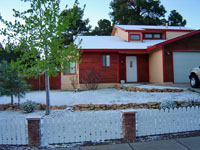 paper. The topic was how well, or poorly, the local paper covers
the news. Somewhere along the way, a guy from the Sierra Club
made exactly that absurd
paper. The topic was how well, or poorly, the local paper covers
the news. Somewhere along the way, a guy from the Sierra Club
made exactly that absurd
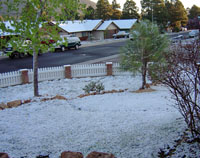 remark
- how our drought was an indicator of global warming. How stupid
are these people? Well, the question answers itself. Even
just a couple of weeks ago, a letter ran in the paper wherein the
writer claimed to have seen the consequences of global warming where
he lived . . . in Canada, or someplace. As John Stossel would
say, "Give me a break!" remark
- how our drought was an indicator of global warming. How stupid
are these people? Well, the question answers itself. Even
just a couple of weeks ago, a letter ran in the paper wherein the
writer claimed to have seen the consequences of global warming where
he lived . . . in Canada, or someplace. As John Stossel would
say, "Give me a break!"
Well, this past Saturday, which, I will remind the casual reader, was
May 4th, we receive a decent little snowfall. And, later in the
day, it snowed a couple of times, at least in my neighborhood.
Not enough to accumulate, but, then, again, it is MAY!! Yet,
where are the global warming nuts now? Why isn't this
"evidence", against global warming alarmism, equal to the
"evidence" they so blithely pass off every other day of the
week? I guess it's because they aren't really interested in
evidence anyway. They are too busy pursuing their agenda of the
destruction of human progress. [Click
on either photo for a larger image.]
|
|

|
|
Saturday,
May 19, 2007
  Butchart
at 100
- In
the Cline Library, at Northern Arizona University, a special
"birthday" remembrance was held for Harvey Butchart, the
grand master of hiking the Grand Canyon. He spent some 1200 days
in the canyon, and with my paltry 523, I am unlikely to ever catch up
to that record! The organizers even baked a cake, as Butchart
at 100
- In
the Cline Library, at Northern Arizona University, a special
"birthday" remembrance was held for Harvey Butchart, the
grand master of hiking the Grand Canyon. He spent some 1200 days
in the canyon, and with my paltry 523, I am unlikely to ever catch up
to that record! The organizers even baked a cake, as 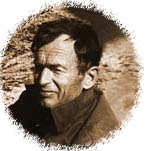 you
can see. Alas, except for a late poker game, I would have stayed
around to have some. you
can see. Alas, except for a late poker game, I would have stayed
around to have some.
The program was a look at Harvey's life, which has just been
chronicled in the book Grand Obsession: Harvey
Butchart and the Exploration of Grand Canyon's Backcountry.
The authors, Elias Butler and Tom Myers, were also the speakers for
this slide show retrospective. Fascinating stuff, and their book
should be available . . . soon, I hope.
I only met Harvey once, and that was ten years ago, at his 90th
birthday party, also held in the Cline Library Auditorium. I was
able to get him to sign my Grand
Canyon Treks book, the first of three he wrote, and which I had
used rigorously for years. In retrospect, perhaps I should have
asked him to sign the newer edition, which has all three volumes
together.
I did correspond with Harvey, although just briefly. In the
early 1990s, reprints of his 1000+ page journal required his
permission, which he kindly granted to me. I also wrote to him
about a house structure in Vishnu canyon. While doing a
Nankoweap to Phantom hike in 1993 (10 days and 9 nights), Neil Jacobs
and I were having lunch on the Tonto, overlooking Vishnu, which we had
just crossed. And, there, on a terrace, was the unmistakable
sign of a house outline. I hadn't read of any such structure in
Harvey's books, nor journal, so I penned a letter to him soon after
the hike was over. He responded quickly, which was one of his
traits, and said that he hadn't seen any such structure in lower
Vishnu, but that as much as he had hiked (and, he was done hiking by
that time), there were always things you'd miss.
Well, we will still miss Harvey - he was an inspiration to me, and to
many others that have hiked in odd, out of the way places, in the
Grand Canyon.
 Related
blog:
Remembering
George Steck
Related
blog:
Remembering
George Steck
|
|

|
|
Wednesday,
May 30, 2007

Click on
(almost) any picture for a larger image.
 Missouri
Breaks
- A
couple of weeks ago, I was able to spend 6 days in, and around, Saint
Louis, Missouri, in the middle of my wife's two week stint on a
business trip. While on this trip, I made a number of
observations . . . Missouri
Breaks
- A
couple of weeks ago, I was able to spend 6 days in, and around, Saint
Louis, Missouri, in the middle of my wife's two week stint on a
business trip. While on this trip, I made a number of
observations . . .
 Economy
parking and luggage -
I haven't used the economy parking lot, at Phoenix's Sky Harbor
Airport, in many years. But, this trip was different. I
found a space in the East lot and waited for the bus. One
family, also waiting, must have had ten pieces of luggage.
What a hassle getting on the shuttle, and, at the terminal, getting
off. Wouldn't it have made better sense to cough up the $3
minimum charge for the parking garage, adjacent to the terminal, in
order to transfer the luggage to the ticketing area, and, then,
drive the vehicle over to the economy lot? I would think so!
Economy
parking and luggage -
I haven't used the economy parking lot, at Phoenix's Sky Harbor
Airport, in many years. But, this trip was different. I
found a space in the East lot and waited for the bus. One
family, also waiting, must have had ten pieces of luggage.
What a hassle getting on the shuttle, and, at the terminal, getting
off. Wouldn't it have made better sense to cough up the $3
minimum charge for the parking garage, adjacent to the terminal, in
order to transfer the luggage to the ticketing area, and, then,
drive the vehicle over to the economy lot? I would think so!
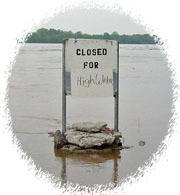  The
charm and history of Ste. Genevieve -
We spent a weekend in Ste. Genevieve, about 50 miles south of St.
Louis. The town is more than 250 years old, and was a hot spot
during the French colonial days. There are many historic homes
here that span a couple of centuries in age, and quite a few were
still being lived in some 40-50 years ago! We stayed in the Main
Street Inn B&B. Included in the room charge was wine
tasting at the Charleville
Winery Tasting Room, adjacent to us. The Mississippi has
been flooding for a bit, and the local ferry was unavailable for
crossing. I guess this doesn't happen too often, as the owners
just posted a hand written sign!
The
charm and history of Ste. Genevieve -
We spent a weekend in Ste. Genevieve, about 50 miles south of St.
Louis. The town is more than 250 years old, and was a hot spot
during the French colonial days. There are many historic homes
here that span a couple of centuries in age, and quite a few were
still being lived in some 40-50 years ago! We stayed in the Main
Street Inn B&B. Included in the room charge was wine
tasting at the Charleville
Winery Tasting Room, adjacent to us. The Mississippi has
been flooding for a bit, and the local ferry was unavailable for
crossing. I guess this doesn't happen too often, as the owners
just posted a hand written sign!
 Wine
restrictions do impact others! -
In the wine tasting room, I chatted with Denice about Arizona recently
relaxing its prohibition on wine sales, direct to consumers, from
out-of-state wineries. She said that it has made a difference,
even to this little winery so far away. She said that it is
quite a hassle trying to figure out to whom they can ship wine to
legally. In fact, they let FedEx figure it out for them!
Something else we learned, while in Ste. Genevieve, was that Missouri
was the second largest producer of wine prior to Prohibition.
Then, the vineyards were literally destroyed, and they are still
rebuilding this industry!
Wine
restrictions do impact others! -
In the wine tasting room, I chatted with Denice about Arizona recently
relaxing its prohibition on wine sales, direct to consumers, from
out-of-state wineries. She said that it has made a difference,
even to this little winery so far away. She said that it is
quite a hassle trying to figure out to whom they can ship wine to
legally. In fact, they let FedEx figure it out for them!
Something else we learned, while in Ste. Genevieve, was that Missouri
was the second largest producer of wine prior to Prohibition.
Then, the vineyards were literally destroyed, and they are still
rebuilding this industry!
 Service
counts! -
When we were in St. Louis, at the Hilton Hotel, the difference
between it and the B&B was . . . palpable. The service was
fabulous in Ste. Genevieve, and practically non-existent in St.
Louis. The B&B owners set out a coffee urn in the morning, so
that we could have fresh java before breakfast. So, why can't
the Hilton do the same thing, on each floor of the hotel?
Making coffee in the room is about seventeen grades below fresh
brewed. And, the price of the rooms in the two locales were
comparable.
Service
counts! -
When we were in St. Louis, at the Hilton Hotel, the difference
between it and the B&B was . . . palpable. The service was
fabulous in Ste. Genevieve, and practically non-existent in St.
Louis. The B&B owners set out a coffee urn in the morning, so
that we could have fresh java before breakfast. So, why can't
the Hilton do the same thing, on each floor of the hotel?
Making coffee in the room is about seventeen grades below fresh
brewed. And, the price of the rooms in the two locales were
comparable.
 Private
interests can manifest a taste for preservation! -
While the state does chip in to pay expenses for some of the old
homes we saw, most lasted for more than one hundred and fifty years
because someone found them useful and/or because they just wanted to
save them! What a concept. We also visited the Crown
Valley Winery, where the owner has a private herd of elk, and bison,
which are managed for commercial purposes.
Private
interests can manifest a taste for preservation! -
While the state does chip in to pay expenses for some of the old
homes we saw, most lasted for more than one hundred and fifty years
because someone found them useful and/or because they just wanted to
save them! What a concept. We also visited the Crown
Valley Winery, where the owner has a private herd of elk, and bison,
which are managed for commercial purposes.
 Local
currency, of a sort -
We found some coupons on display in the local museum. They
were, essentially, "ice money." They were used to obtain ice,
and, presumably, sold at some kind of discount early in the season
(not unlike ski lift season passes). The booklet reads, "The
coupons in this book are not good if detached and are payable only
in ice." For those with an economics background, this deters
resale for profit. Well, you could sell the whole booklet, but
not the individual coupons, and it would be mighty tedious to go in
with a group to buy, and use, a booklet.
Local
currency, of a sort -
We found some coupons on display in the local museum. They
were, essentially, "ice money." They were used to obtain ice,
and, presumably, sold at some kind of discount early in the season
(not unlike ski lift season passes). The booklet reads, "The
coupons in this book are not good if detached and are payable only
in ice." For those with an economics background, this deters
resale for profit. Well, you could sell the whole booklet, but
not the individual coupons, and it would be mighty tedious to go in
with a group to buy, and use, a booklet.
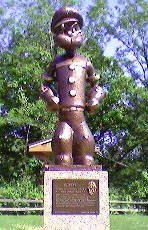   I
y'am what I y'am -
We decided to cross the mighty Mississip at Cape Girardeau, and hit
some sites in Illinois, on our way back to St. Louis. We
happened upon Chester, Ill., home of the cartoonist that created
Popeye. And, there was his statue - Popeye's, that is.
Suddenly, I feel like I am on a road trip with Chevy Chase.
Where is the world's largest ball of string? Right next to
Popeye was a warning sign about bootlegging cigarettes - guilty
parties face imprisonment, fines and having their cars/trucks seized.
Somehow, it strikes me that Popeye is exactly the kind of
"person" you'd expect to buy some bootleg tobacco to fill
his pipe! And, doesn't the fact that arbitrage is profitable
indicate that something is wrong with the tax structure here?
I
y'am what I y'am -
We decided to cross the mighty Mississip at Cape Girardeau, and hit
some sites in Illinois, on our way back to St. Louis. We
happened upon Chester, Ill., home of the cartoonist that created
Popeye. And, there was his statue - Popeye's, that is.
Suddenly, I feel like I am on a road trip with Chevy Chase.
Where is the world's largest ball of string? Right next to
Popeye was a warning sign about bootlegging cigarettes - guilty
parties face imprisonment, fines and having their cars/trucks seized.
Somehow, it strikes me that Popeye is exactly the kind of
"person" you'd expect to buy some bootleg tobacco to fill
his pipe! And, doesn't the fact that arbitrage is profitable
indicate that something is wrong with the tax structure here?
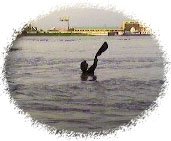  Meet
me in St. Louie -
We reached the 'Gateway to the West' in the early evening and had a
chance to stroll along the river. It seemed odd that stairs
led directly off the sidewalk and right into the water. Then,
we saw this odd shape in the water - upon closer inspection it
turned out to be the head, arm and hat of a statue! Aha - we
are still looking at river that is well above it's normal flow.
We thought that the statue would be suitably captioned, "Come on in,
the water's fine." Later, we saw a picture of the statue -
there is actually another person, and a dog, which were completely
covered up by the water.
Meet
me in St. Louie -
We reached the 'Gateway to the West' in the early evening and had a
chance to stroll along the river. It seemed odd that stairs
led directly off the sidewalk and right into the water. Then,
we saw this odd shape in the water - upon closer inspection it
turned out to be the head, arm and hat of a statue! Aha - we
are still looking at river that is well above it's normal flow.
We thought that the statue would be suitably captioned, "Come on in,
the water's fine." Later, we saw a picture of the statue -
there is actually another person, and a dog, which were completely
covered up by the water.
  Never
on a Monday -
On Monday, I decided to do some touring of the area. One place
I wanted to see was Fort de Chartres, initially built by the French
in the early 1700s. I was
Never
on a Monday -
On Monday, I decided to do some touring of the area. One place
I wanted to see was Fort de Chartres, initially built by the French
in the early 1700s. I was
 quite
excited when I drove up to the visitor parking and saw only one other
vehicle. But, then I found that it was closed on Mondays!
Whaa?? Who's crazy idea is that. At least the place was
big enough to walk around and look at, but no interpretive materials
and the little museum was closed. At least the privies were
open, although, they were mighty dark when the doors were closed. quite
excited when I drove up to the visitor parking and saw only one other
vehicle. But, then I found that it was closed on Mondays!
Whaa?? Who's crazy idea is that. At least the place was
big enough to walk around and look at, but no interpretive materials
and the little museum was closed. At least the privies were
open, although, they were mighty dark when the doors were closed.
This incident was made the worse for the fact
that we had thought to stop by here on Sunday, while driving up to St.
Louis. Instead, we visited Fort Kaskaskia, which is not really a
fort at all - only some earthen mounds. But, it is a very nice
picnic area, and it does have a few interpretive signs in the
area. Live and learn. So one hopes!
  Marxism
at the Cohokia Mounds -
I did get a chance to visit the Cohokia Mounds. This is the site
of the largest population of Indians north of Mexico. About a
thousand years ago, there were some 20,000+ people living in this
area, east of St. Louis just a few miles (in Illinois). They
built earthen mounds, the largest of which is called Monk's
Mound. At it's base it is larger than the famous pyramids in
Egypt and in Mexico. It must have taken a long time to build,
and there are many other, smaller ones.
Marxism
at the Cohokia Mounds -
I did get a chance to visit the Cohokia Mounds. This is the site
of the largest population of Indians north of Mexico. About a
thousand years ago, there were some 20,000+ people living in this
area, east of St. Louis just a few miles (in Illinois). They
built earthen mounds, the largest of which is called Monk's
Mound. At it's base it is larger than the famous pyramids in
Egypt and in Mexico. It must have taken a long time to build,
and there are many other, smaller ones.
 There is a fine interpretive center there, and I enjoyed my visit
quite a bit. But, there was one display, which listed various
criteria for determining whether a place is really a "city" or
not, and then compared how Cohokia stacked up against St. Louis.
The third item in the list was titled, "Surplus
Capital." Ouch! [Click on the photo to the left to
see the entire sign.] The notion of a "surplus" of
capital is strictly Marxist gobbledy-gook. If you really want to
describe any capital above, and beyond, pure subsistence, as a
surplus, then the world is rife with such stuff, and has been for a
very, very long time.
There is a fine interpretive center there, and I enjoyed my visit
quite a bit. But, there was one display, which listed various
criteria for determining whether a place is really a "city" or
not, and then compared how Cohokia stacked up against St. Louis.
The third item in the list was titled, "Surplus
Capital." Ouch! [Click on the photo to the left to
see the entire sign.] The notion of a "surplus" of
capital is strictly Marxist gobbledy-gook. If you really want to
describe any capital above, and beyond, pure subsistence, as a
surplus, then the world is rife with such stuff, and has been for a
very, very long time.
 Touring
downtown St. Louis -
I also spent a day in town, and got to visit the Arch, and the
museum underneath it. I did take the egg-shaped tram ride to
the top. Pretty cool stuff, especially with five people in a
car, having to keep your head slightly bent over, and with cars that
do quite a bit of wobbling about. The views from the top are
stunning, as one would expect. Later, I walked by the St.
Louis Federal Reserve District Bank. I use their data all the
time, but you can't go inside for a tour unless you have a group of
fifteen, or more. It is a funny building, with an entrance
that is now only about 20 feet from the next building.
Touring
downtown St. Louis -
I also spent a day in town, and got to visit the Arch, and the
museum underneath it. I did take the egg-shaped tram ride to
the top. Pretty cool stuff, especially with five people in a
car, having to keep your head slightly bent over, and with cars that
do quite a bit of wobbling about. The views from the top are
stunning, as one would expect. Later, I walked by the St.
Louis Federal Reserve District Bank. I use their data all the
time, but you can't go inside for a tour unless you have a group of
fifteen, or more. It is a funny building, with an entrance
that is now only about 20 feet from the next building.
|
|

|
|
Thursday,
May 31, 2007
 Water
on the Brain
- The Arizona Daily Sun ran an editorial yesterday chastising
city officials for overstating our "problem" with
water. Of course, the problem is that the city is the provider
and nobody there seems to have a clue about economics. At issue
is that city wells are at/near their capacity. That may seem
scary, but these wells represent slightly less than 60% of our
available water supply. And, current usage is only running at
about 53% of available supply (on a daily basis). To that, the
editor wonders, "[W]hy is the city still enforcing automatic
watering restrictions?" Water
on the Brain
- The Arizona Daily Sun ran an editorial yesterday chastising
city officials for overstating our "problem" with
water. Of course, the problem is that the city is the provider
and nobody there seems to have a clue about economics. At issue
is that city wells are at/near their capacity. That may seem
scary, but these wells represent slightly less than 60% of our
available water supply. And, current usage is only running at
about 53% of available supply (on a daily basis). To that, the
editor wonders, "[W]hy is the city still enforcing automatic
watering restrictions?"
I wish we had a good reason. Unfortunately, we only have a bad
reason - they restrict because they can. The editorial points
out that daily usage has fallen by only 5% to 10% as a result of these
restrictions, and, yet, there is no crisis. This case
illustrates how government ignores costs in weighing its
decisions. Instead, someone pops off about "saving
water" or "preserving our precious resource," and fails
to consider the full benefits and costs. As to benefits, there
apparently aren't any! At least, that was the conclusion of the
editor.
And, what of costs? On that score, there are plenty. If
many homeowners are like me, water usage is down, and landscapes are
deteriorating, because watering, on the city's schedule, is
inconvenient. I am allowed to water on Tuesdays, Thursdays and
Saturdays. If I want to go somewhere for the weekend, I end up
with an unwatered lawn for four days. That turns out not to be
very good for the lawn. Of course, some activists will put on
their smug smiles, and cheer on the death of my grass, because they
know what is best for me.
There is much waste associated with a failure to price resources
properly. By properly, I mean according to the relative costs of
production and values placed on them by consumers. Prices
reflect the aggregation of our tastes and preferences. By
engaging in non-price allocation (i.e., restricting water usage), it
encourages outcomes that are inefficient, especially relative to the use
of our scarce time.
For example, if I want to go hiking up at the Grand Canyon, on a
Tuesday, I can't water on Monday to compensate. Even though I am
not planning on watering any more often than is "allowed" I
don't get the choice of picking times that are convenient to me.
Instead, I have to adjust my watering times to fit their schedule, so
that they can more easily monitor our usage. So, while it is
least costly to the city to engage in regulations of this type, it is
a false economy. The true, and full, costs are borne by
users. Either I postpone, or cancel, my hiking trip, or I stress
out my lawn by skipping a day.
So, what is the "right" solution? It is to price the
water such that some targeted amount is used. If we use
"too much" then the price should be raised. If
it is set in a graduated manner, then heavy water users will pay more,
on a per gallon basis, than light users. Then, you don't need to
police homeowners, and I can water whenever is convenient to me, not
whenever is convenient to the city council.
|
|

|

|

|

|

|